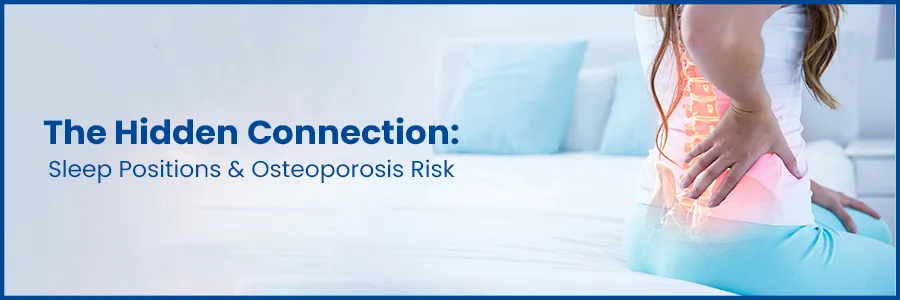
The Hidden Connection: Sleep Positions and Osteoporosis Risk
Sleep, an essential component of overall well-being, plays a vital role in maintaining our health. While the importance of sleep duration and quality is well-known, a lesser-known aspect is the potential connection between sleep positions and osteoporosis risk. Osteoporosis, a condition characterized by weakened and brittle bones, affects millions worldwide. In this blog, we will explore the hidden link between sleep positions and osteoporosis risk, shedding light on how our nightly rest can impact bone health.
Understanding Osteoporosis
Osteoporosis is a bone disorder that leads to reduced bone density and increased susceptibility to fractures. As bones become porous and fragile, even a minor bump or fall can result in severe fractures, impacting an individual's mobility and quality of life. Although age, genetics, and hormonal changes play significant roles in osteoporosis development, lifestyle factors also contribute to bone health.
Sleep Positions and Bone Health
Recent research has uncovered a potential association between sleep positions and osteoporosis risk. While the connection is not as straightforward as some other factors, it is worth exploring how sleep positions might impact bone health.
- Side Sleeping: Sleeping on your side is a common position, but it may impact bone health. If you consistently sleep on one side, it can lead to an uneven distribution of pressure on the bones, potentially causing discomfort over time. Additionally, when one arm is positioned beneath the head, it might hinder blood circulation and nerve function in that limb.
- Back Sleeping: Sleeping on your back is generally considered a neutral position for bone health. It evenly distributes weight and minimizes pressure on specific areas, reducing the risk of developing pressure sores. However, prolonged immobility in any position can lead to stiffness and discomfort.
- Stomach Sleeping: Sleeping on your stomach is often discouraged due to its potential negative effects on the spine's alignment. This position can strain the neck and lower back, potentially causing discomfort and misalignment that may affect overall posture.
Secure your health with a second opinion. Make informed decisions and book your appointment today!
Get A Second OpinionOsteoporosis Risk and Sleep Position:
While sleep positions can influence comfort and spinal alignment, more research is needed to establish a direct link between sleep positions and Osteoporosis risk. However, it is crucial to consider the potential impact of sleeping positions on overall bone health.
Tips for Better Sleep and Bone Health:
- Rotate Positions: If you have a preferred sleep position, try to switch it up occasionally to prevent excessive pressure on certain areas of your body.
- Optimal Pillow Support: Choose a pillow that provides adequate support for your neck and spine, regardless of your sleep position.
- Regular Exercise: Engage in weight-bearing exercises like walking, jogging, or strength training to promote bone health.
- Balanced Diet: Consume a diet rich in calcium and vitamin D to support bone strength.
- Consult a Professional: If you're concerned about sleep positions and bone health, consider discussing the matter with a healthcare professional or a sleep specialist.
Expert Insights:
Medicover's dedicated team of doctors brings a wealth of knowledge and experience to the intersection of sleep positions and osteoporosis risk. While the exact correlation between sleep positions and osteoporosis is not yet fully understood, Orthopedic Experts emphasize the value of adopting healthy sleep habits, balanced nutrition, and regular exercise to support overall bone health.
Conclusion:
While the hidden connection between sleep positions and osteoporosis risk requires further investigation, it's clear that sleep plays an important role in overall health, including bone health. Prioritizing good sleep hygiene, maintaining a balanced diet, and staying physically active are key components of supporting strong bones. As research continues to unravel the complexities of this connection, individuals can make informed choices about their sleep positions to potentially enhance their bone health and overall well-being.
Secure your health with a second opinion. Make informed decisions and book your appointment today!
Book an AppointmentFrequently Asked Questions
While research is ongoing, there is no definitive direct link between sleep positions and osteoporosis risk. However, certain sleep positions can potentially influence bone health by affecting blood circulation and pressure on bones.
Prolonged pressure on specific bones due to habitual sleep positions could potentially impact bone density over time. However, the influence of sleep positions on bone density is still being studied.
No sleep position has been definitively proven to prevent osteoporosis. However, maintaining good sleep posture and periodically changing positions may help prevent undue pressure on specific areas.
The best sleep position for your bone health might depend on your individual preferences and comfort. It's important to prioritize sleep quality and consult with a healthcare specialist if you have concerns about bone health.
Yes, sleep positions can potentially affect spinal alignment and posture. Certain positions, if held for extended periods, might strain the spine and contribute to discomfort.
Changing sleep positions periodically can help prevent prolonged pressure on specific bones and enhance circulation. However, other factors like nutrition and exercise also play a significant role in bone health.
A supportive mattress and pillows that promote proper spinal alignment can contribute to overall musculoskeletal well-being during sleep.
Yes, adopting a balanced diet rich in calcium and vitamin D, engaging in weight-bearing exercises, and practicing good sleep hygiene can all contribute to better bone health.
Osteoporosis prevention requires a holistic approach that includes a Proper balanced diet, regular exercise, and other lifestyle factors. Sleep position adjustments can be a small part of this approach.
If you have concerns about sleep positions and their potential impact on bone health, it's a good idea to consult a healthcare professional. They can provide personalized guidance and recommendations based on your individual circumstances.
